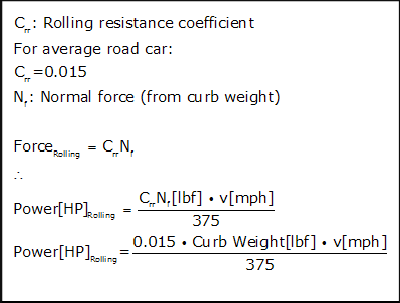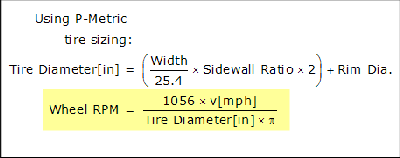IntroductionThe gas mileage that a vehicle gets is dependent upon a lot of factors. In this article, I will be looking at how to choose a suitable axle ratio to obtain reasonably good gas mileage at highway speeds. Table of ContentsResistanceThere are several sources of resistance that the engine has to overcome in order to keep a car cruising at highway speeds:
Aerodynamic DragWhen a car is moving, air resists the motion. In ideal conditions, such as on a calm day at freezing temperatures, the power needed to overcome aerodynamic drag can be calculated using the equation seen below: 
Given the vehicle speed and aerodynamic drag, the power needed to travel through the air can be calculated. Engine Friction and Drivetrain LossesA piston engine loses a lot of energy to internal friction. The valvetrain, rotating assembly, and other moving parts all consume power. Generally speaking, the smaller the parts are, the fewer parts there are, or the slower the parts are moving, the less energy they will consume. This is why large engines tend to use more fuel than smaller engines. However, if a large engine can be turned very slowly and still make sufficient power, the losses due to friction decrease, and can in fact be lower than that of a smaller engine. The fact that high revs cause an engine to use more fuel is why many cars are fitted with camshafts that help the engine make power at low RPM, while sacrificing power higher in the rev range. An engine makes the most power relative to the mass flow rate of the fuel when it is revving at its torque peak. The small cams bring the torque peak near the cruising RPM, which means that the engine will get as good mileage as possible while cruising. The drivetrain on a two wheel drive car with a manual transmission can transfer approximately 80% of the engine's power to the road. A car with an automatic can transfer about 75%, although lockup clutches and other technologies have raised this number on modern vehicles. Rolling FrictionThere is a great deal of friction between the tires and the road, which varies with the size of the tires, the type of tires used, and the weight of the car. The amount friction can be reduced by using tires that are smaller, or made from a harder compound. Smaller, harder tires offer less traction, which negatively affects handling and braking, which is probably why almost every automaker uses much larger tires than they would have 25 years ago. 
Rolling resistance is dependent upon the resistance coefficient of the tires, and the weight on the tires. CruisingIt takes no energy to keep a moving object in motion, but because there are sources of resistance, the engine must be kept running at all times to maintain a constant cruising speed. The engine must make enough power to be able to overcome all of the sources of resistance, and have some left over for acceleration. The minimum amount of power left over for acceleration is difficult to quantify. Cars that are heavy, have few transmission gears, or high aerodynamic drag will need to have a bit more "extra" power so that dropping down a gear can be avoided. A car that has a transmission with many gears can get away with having to gear down because the engine will not rev way up and use much more fuel to overcome its own friction. As a general rule, 0.10g of acceleration is acceptable on the highway, but 0.12 or even 0.15g is probably better. To find the power that the engine needs to make for highway cruising, the sum of all of the sources of resistance along with the power needed to pull 0.10-0.15g of acceleration must be found. 
Power needed for cruising can be found using the enormous equation seen above. Choosing a Final Drive RatioOnce the power needed to cruise is found, choosing a final drive ratio is actually fairly simple. The engine needs to be revving at the lowest RPM that it is capable of making the necessary power, so the final drive gear must accomodate this. The first step is to determine the RPM that the wheels will be turning at when the car is cruising along. The formula is shown below. 
Finding rear wheel RPM from tire diameter. The second step is to determine the lowest RPM that the engine can make the needed power. This can only be done by looking at the engine's power curve. Once the lowest RPM has been determined, the axle ratio can be found using the equation below: 
Finding the final drive ratio from the wheel RPM and engine RPM. ConclusionChoosing a suitable gear ratio for gas mileage is difficult because there are so many factors. However, some assumptions can be made that allow a reasonable choice to be made. Low RPM is favourable to help reduce losses due to friction, but the engine must be able to make sufficient power to avoid have to gear down for hills or to pass other cars. See Also |
|
|
|||||
|
|